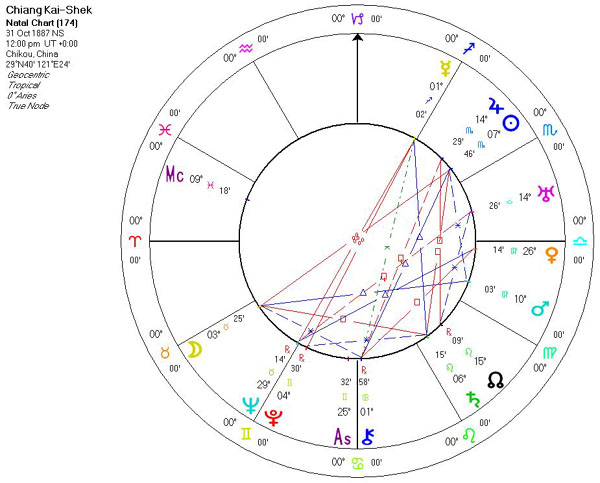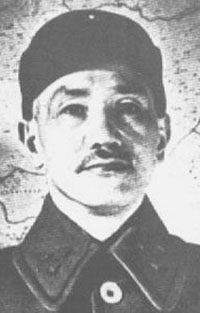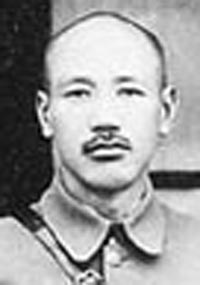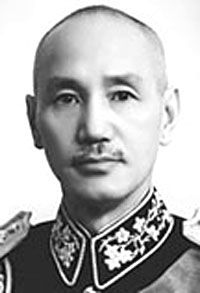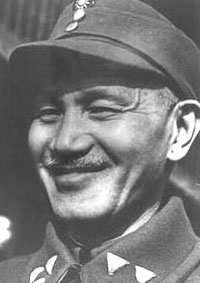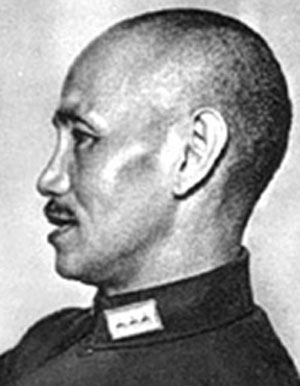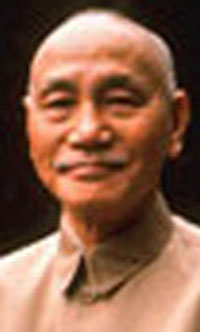Michael D. Robbins © 2002
Astro-Rayological
Interpretation & Charts
Quotes
Biography
Images and Physiognomic Interpretation
Don't be disquieted in time of adversity. Be firm with dignity and self-reliant with vigor.
(Saturn in Leo)My good health is due to a soup made of white doves. It is simply wonderful as a tonic.
Prayer is more than meditation. In meditation the source of strength is one's self. When one prays he goes to a source of strength greater than his own.
I go walking, and the hills loom above me, range upon range, one against the other. I cannot tell where one begins and another leaves off. But when I talk with God He lifts me up where I can see clearly, where everything has a distinct contour.
We live in the present, we dream of the future and we learn eternal truths from the past.
We write our own destiny . . . we become what we do.
Chiang Kai-shek (October 31, 1887 – April 5, 1975) was a Chinese military and political leader who assumed the leadership of the Kuomintang (KMT) after the 1925 death of Sun Yat-sen. He led the national government of the Republic of China from 1928 to 1975. He began his military education at the Baoding Military Academy, in 1906, attended the Military State Academy in Japan in 1907. Chiang Kai-shek served in the Imperial Japanese Army from 1909 to 1911. He commanded the Northern Expedition to unify China against the warlords and emerged victorious in 1928 as the overall leader of the Republic of China (ROC). Chiang led China in the Second Sino-Japanese War, during which Chiang's stature within China weakened, but his international prominence grew. During the Chinese Civil War (1927–1949), Chiang attempted to eradicate the Chinese Communists, but ultimately failed, forcing his government to retreat to Taiwan, where he continued serving as the President of the Republic of China and Director-General of the KMT for the remainder of his life.
] Early life
Chiang Kai-shek was born in the town of Xikou, China, approximately 33 km (20.5 miles) southwest of downtown Ningbo, in Fenghua County, Ningbo Prefecture, Zhejiang Province. However, his ancestral home, a concept important in Chinese society, was the town of Heqiao (???) in Yixing County, Wuxi Prefecture, Jiangsu Province (approximately 38 km or 24 miles southwest of downtown Wuxi, and 10 km (6 miles) from the shores of the famous Lake Taihu).His parents were Chiang Zhaocong (???) and Wang Caiyu (???), part of an upper-middle class family of salt merchants. His father died when he was only three, and he wrote of his mother as the "embodiment of Confucian virtues." In an arranged marriage, Chiang was married to fellow villager Mao Fumei1. Chiang and Mao had a son Ching-Kuo and a daughter Chien-hua (??).
Chiang grew up in an era in which military defeats had left China destabilized and in debt, and he decided to join the military. He began his military education at the Baoding Military Academy, in 1906. He left for the Military State Academy in Japan in 1907. There he was influenced by his compatriots to support the revolutionary movement to overthrow the Qing Dynasty and to set up a Chinese Republic. He befriended fellow Zhejiang native Chen Qimei, and, in 1908, Chen brought Chiang into the Tongmenghui. Chiang served in the Imperial Japanese Army from 1909 to 1911.
Rise to power
With the outbreak of the Wuchang Uprising, in 1911, Chiang Kai-shek returned to China to fight in the revolution as an artillery officer. He served in the revolutionary forces, leading a regiment in Shanghai under his friend and mentor Chen Qimei. The revolution was ultimately successful in overthrowing the Qing Dynasty and Chiang became a founding member of the Kuomintang.After takeover of the Republican government by Yuan Shikai and the failed Second Revolution, Chiang, like his Kuomintang comrades, divided his time between exile in Japan and havens in Shanghai's foreign concession areas. In Shanghai, Chiang also cultivated ties with the criminal underworld dominated by the notorious Green Gang and its leader Du Yuesheng. Chiang had numerous brushes with the law during this period and the International Concession police records show an arrest warrant for him for armed robbery. On February 15, 1912, Chiang Kai-shek shot and killed Tao Chengzhang, the leader of the Restoration Society, at point-blank range as Tao lay sick in a Shanghai French Concession hospital, thus ridding Chen Qimei of his chief rival. On May 18, 1916, Chen Qimei was assassinated by agents of Yuan Shikai and Chiang succeeded him as the leader of the Chinese Revolutionary Party in Shanghai. This was during a low point in Sun Yat-sen's career, with most of his old Revolutionary Alliance comrades refusing to join him in the exiled Chinese Revolutionary Party, and Chen Qimei having been Sun's chief lieutenant in the party.
Chiang Kai-shek was appointed by Sun Yat-sen as Commandant of the Whampoa Military Academy.In 1917, Sun Yat-sen moved his base of operations to Guangzhou and Chiang joined him in 1918. Sun, at the time was largely sidelined and without arms or money, was soon expelled from Guangzhou, in 1918, and exiled again to Shanghai, but restored again with mercenary help in 1920. However, a rift had developed between Sun, who sought to militarily unify China under the KMT, and Guangdong Governor Chen Jiongming, who wanted to implement a federalist system with Guangdong as a model province. On June 16, 1923, Chen attempted to expel Sun from Guangzhou and had his residence shelled. Sun and his wife Soong May-ling narrowly escaped under heavy machine gun fire and were rescued by gunboats under the direction of Chiang Kai-shek. The incident earned in Chiang Kai-shek the trust of Sun Yat-sen.Sun regained control in Guangzhou in early 1924 with the help of mercenaries from Yunnan, and accepted aid from the Comintern. He then undertook a reform of the Kuomintang and established a revolutionary government aimed at unifying China under the KMT. That same year, Sun sent Chiang Kai-shek to spend three months in Moscow studying the Soviet political and military system. Chiang's eldest son, Ching-kuo, remained in Russia until 1937. Chiang Kai-shek returned to Guangzhou and in 1924 was made Commandant of the Whampoa Military Academy. The early years at Whampoa allowed Chiang to cultivate a cadre of young officers loyal to him and, by 1925, Chiang's proto-army was scoring victories against local rivals in Guangdong province. Here he also first met and worked with a young Zhou Enlai, who was selected to be Whampoa's Political Commissar. However, Chiang was deeply critical of the Kuomintang-Communist Party United Front, suspicious that the Communists would take over the KMT from within.
Throughout his rise to power, Chiang Kai-Shek also benefitted from membership of the nationalist Tiandihui fraternity, to which Sun Yat-Sen also belonged, and which remained a source of support during his leadership of China and later Taiwan.
Succession of Sun Yat-Sen
Chiang Kai-shek in 1926, during the Northern Expedition.With Sun Yat-sen's death in 1925, a power vacuum developed in the KMT. A power struggle ensued between Chiang, who leaned towards the right wing of the KMT, and Sun Yat-sen's close comrade-in-arms Wang Jingwei, who leaned towards the left wing of the party. Though Chiang ranked relatively low in the civilian hierarchy, and Wang had succeeded Sun to power as Chairman of the National Government, Chiang's deft political maneuvering following the Zhongshan Warship Incident eventually allowed him to emerge victorious. Chiang, who became Commander-in-Chief of the National Revolutionary Forces in 1925, launched in July 1926 the Northern Expedition, a military campaign to defeat the warlords controlling northern China and unify the country under the KMT.The National Revolutionary Army branched into three divisions—to the west, Wang Jingwei led a column to take Wuhan; to the east, Bai Chongxi led another column to take Shanghai; while Chiang led in the middle to take Nanjing—before they were to press ahead to take Beijing. However, in January 1927, allied with the Chinese Communists and Soviet Agent Mikhail Borodin, Wang Jingwei and his KMT leftist allies having taken the city of Wuhan amid much popular mobilization and fanfare, declared the National Government to have moved to Wuhan. After taking Nanjing in March (and with Shanghai under the control of his close ally General Bai), Chiang momentarily halted his campaign and decided to break with the leftists.
On April 12, Chiang began a swift and brutal attack on thousands of suspected Communists. He then established his own National Government in Nanjing, supported by his conservative allies (including Hu Hanmin. The communists were purged from the KMT and the Soviet advisers were expelled. This earned Chiang the support and financial backing of the Shanghai business community, and maintained him the loyalty of his Whampoa officers (many of whom hailed from Hunan elites were discontented by the land redistribution Wang Jingwei was enacting in the area), but led to the beginning of the Chinese Civil War. Wang Jingwei's National Government, though popular with the masses, was weak militarily and was soon overtaken by a local warlord, forcing Wang and his leftist government into joining him in Nanjing. Finally, the warlord capital of Beijing was taken in June 1928 and in December, the Manchurian warlord Zhang Xueliang pledged allegiance to Chiang's government.
Chiang made gestures to cement himself as the successor of Sun Yat-sen. In a pairing of much political significance, Chiang married, on December 1, 1927, Soong May-ling, the younger sister of Soong Ching-ling (Sun Yat-sen's widow, whom he had proposed to beforehand but by whom he had been swiftly rejected) in Japan and thus positioned himself as Sun Yat-sen's brother-in-law. (To please Soong's parents, Chiang had to first divorce his first wife and concubines and promise eventually to convert to Christianity. He was baptized in 1929.) Upon reaching Beijing, Chiang paid homage to Sun Yat-sen and had his body moved to the capital Nanjing to be enshrined in a grand mausoleum.
Tutelage over China
Chiang Kai-shek gained nominal control of China, but his party was too weak to lead and too strong to be overthrown. In 1928, Chiang was named Generalissimo of all Chinese forces and Chairman of the National Government, a post he held until 1932 and later from 1943 until 1948. According to Sun Yat-sen's plans, the Kuomintang was to rebuild China in three steps: military rule, political tutelage, and finally constitutional rule. The ultimate goal of the Kuomintang revolution was democratic rule, which was not feasible in China's fragmented state. Since the Kuomintang had completed the first step of the revolution through its seizure of power in 1928, Chiang's rule thus began the period of political tutelage under the dictatorship of the Kuomintang, to prepare China for the final transitional to constitutional democracy. During this period, many features of a modern, functional Chinese state emerged and developed.The decade of 1928 to 1937 was one of consolidation and accomplishment for Chiang's government. Some of the harsh aspects of foreign concessions and privileges in China were moderated through diplomacy. The government acted energetically to modernize the legal and penal systems, stabilize prices, amortize debts, reform the banking and currency systems, build railroads and highways, improve public health facilities, legislate against traffic in narcotics, and augment industrial and agricultural production. Great strides also were made in education and, in an effort to help unify Chinese society—the New Life Movement was launched to stress Confucian moral values and personal discipline. Standard Mandarin, then known as Guoyu, was promoted as a standard tongue. The widespread establishment of communications facilities further encouraged a sense of unity and pride among the people.
These successes, however, were met with constant upheavals with need of further political and military consolidation. Though much of the urban areas were now under the control of his party, the countryside still lay under the influence of severely weakened yet undefeated warlords and communists. Chiang fought with most of his warlord allies, with one northern rebellion—against the warlords Yen Hsi-shan and Feng Yuxiang—in 1930 during the Central Plains War. It almost bankrupted the government and cost almost 250,000 casualties on both sides. When Hu Han-min established a rival government in Guangzhou in 1931, Chiang's government was nearly toppled. A complete eradication of the Communist Party of China eluded Chiang. The Communists regrouped in Jiangxi and established the Chinese Soviet Republic. Chiang's anti-communist stance attracted the aid of German military advisers, and in Chiang's fifth campaign to defeat the Communists in 1934, he surrounded the Red Army only to see the Communists escape through the epic Long March to Yan'an.
Wartime leader of China
After Japan's invasion of Manchuria in 1931, Chiang resigned as Chairman of the National Government. He returned shortly, adopting a slogan "first internal pacification, then external resistance", which meant that the government would first attempt to defeat the Communists before engaging in the Japanese directly. But Japan's advance on Shanghai and bombardment of Nanjing in 1932 disrupted Chiang Kai-shek's offensives against Communists. Even though on the surface Chiang seemed more preoccupied with eradicating the communists first, Chiang was preparing to fight an eventual showdown with Japan. During the period from 1931 to the beginning of full-scale war in 1937, the central government under Chiang worked assiduously to expand and modernize its armed forces, build fortifications and communication lines around the country, and develop a viable military industry capable of supporting the war effort. All these war preparations required temporary peace with Japan, which was precisely what Chiang sought in his policy. Any premature act of war before the country was ready would likely spell disaster for China. However, this policy of avoiding a frontal war was widely unpopular.In December 1936, Chiang flew to Xi'an to coordinate a major assault on Red Army forces holed up in Yan'an. However, Chiang's allied commander Chang Hsueh-liang, whose forces were to be used in his attack and whose homeland of Manchuria had been invaded by the Japanese, had other plans. On December 12, Chang Hsueh-liang and several other Nationalist generals kidnapped Chiang Kai-shek for two weeks in what is known as the Xi'an Incident. They forced Chiang into making a "Second United Front" with the Communists against Japan. Although the KMT and the CCP never cooperated particularly well, this episode at least brought a halt to fratricidal war and delineated several important areas of cooperation. The rising tide of Chinese nationalism and the cessation of warfare against the communists propelled Chiang Kai-shek in the pinnacle of his political career. He was seen as the only leader capable of leading the nation into a war against Japan.
Generalissimo and Madame Chiang Kai-shek with General Stilwell in Burma (1942).The Second Sino-Japanese War broke out in July 1937. In August of the same year, Chiang sent 500,000 of his best trained and equipped soldiers to defend Shanghai. With about 200,000 Chinese casualties, Chiang lost his political base of Whampoa-trained officers. Although Chiang lost militarily, the battle dispelled Japanese claims that it could conquer China in three months and demonstrated to the Western powers (which occupied parts of the city and invested heavily in it) that the Chinese would not surrender under intense Japanese fire. This was skillful diplomatic maneuvering on the part of Chiang, who knew the city would eventually fall, but wanted to make a strong gesture in order to secure Western military aid for China. By December, the capital city of Nanjing had fallen to the Japanese and Chiang moved the government inland to Chongqing. Devoid of economic and industrial resources, Chiang could not counter-attack and held off the rest of the war preserving whatever territory he still controlled, though his strategy succeeded in stretching Japanese supply lines and bogging down Japanese soldiers in the vast Chinese interior who would otherwise have been sent to conquer southeast Asia and the Pacific islands.
With the Attack on Pearl Harbor and the opening of the Pacific War, China became one of the Allied Powers. During and after World War II, Chiang and his American-educated wife Soong May-ling, commonly referred to as "Madame Chiang Kai-shek", held the unwavering support of the United States China Lobby which saw in them the hope of a Christian and democratic China. Chiang Kai-shek's policies were far from Christian or democratic, but this remained unknown to the U.S. public due to strong state-imposed censorship in China and self-imposed censorship in the U.S. during the war years and after. This was especially fomented by the Chiangs' close friendship with TIME magazine publisher Henry Luce.
Generalissimo Chiang Kai-shek, Franklin D. Roosevelt, and Winston Churchill met at the Cairo Conference in 1943 during World War II.Chiang's strategy during the War opposed the strategies of both Mao Zedong and the United States. The U.S. regarded Chiang as an important ally able to help shorten the war by engaging the Japanese occupiers in China. Chiang, in contrast, used powerful associates such as H. H. Kung in Hong Kong to build the ROC army for certain conflict with the communist forces after the end of World War II. This fact was not understood well in the United States. The U.S. liaison officer, General Joseph Stilwell, correctly deduced that Chiang's strategy was to accumulate munitions for future civil war rather than fight the Japanese, but Stilwell was unable to convince Franklin D. Roosevelt of this and precious Lend-Lease armaments continued to be allocated to the Kuomintang. Chiang was recognized as one of the "Big Four" Allied leaders along with Roosevelt, Churchill, and Stalin and traveled to attend the Cairo Conference in November 1943. His wife acted as his translator and adviser.
Losing China
Chiang Kai-shek and Mao Zedong met in the wartime capital of Chongqing, to toast to the Chinese victory over Empire of Japan.When Japan surrendered in 1945, Chiang's Chongqing government was ill-equipped to reassert its authority in eastern China. It was able to reclaim the coastal cities with American assistance, and sometimes that of former Japanese troops, a deeply unpopular move. The countryside in the north was already largely under the control of the Communists, whose forces were better motivated and disciplined than those of the KMT.Following the war, the United States had encouraged peace talks between Chiang and Communist leader Mao Zedong in Chongqing. Distrustful of each other and of the United States' professed neutrality, they soon resorted to all-out war. The U.S. suspended aid to Chiang Kai-shek for much of the period of 1946 to 1948, in the midst of fighting against the People's Liberation Army led by Mao Zedong. Though Chiang had achieved status abroad as a world leader, his government was deteriorating with corruption and inflation. The war had severely weakened the Nationalists both in terms of resources and popularity, while the Communists were strengthened by aid from Stalin, and guerrilla organizations extending throughout rural areas. The Nationalists initially had superiority in arms and men, but their lack of popularity, poor morale, and apparent disorganization soon allowed the Communists to gain the upper hand.
Meanwhile a new Constitution promulgated in 1947, and Chiang Kai-shek was formally elected by the National Assembly to be the first term President of the Republic of China on May 20, 1948.Meanwhile a new Constitution promulgated in 1947, and Chiang was elected by the National Assembly to be President. This marked the beginning of the 'democratic constitutional government' period in KMT political orthodoxy, but the Communists refused to recognize the new Constitution and its government as legitimate.
Chiang resigned as President on January 21, 1949, as KMT forces suffered massive losses against the communists. Vice President Li Tsung-jen took over as Acting President, but his relationship with Chiang soon deteriorated, as Chiang still acted as if he were in power, and Li was forced into exile in the United States under a medical excuse (under Chiang's direction, Li was later formally impeached by the Control Yuan). In the early morning of December 10, 1949, Communist troops laid siege to Chengdu, the last KMT occupied city in mainland China, where Chiang Kai-shek and his son Chiang Ching-kuo directed the defense at the Chengdu Central Military Academy. The aircraft May-ling evacuated them to Taiwan on the same day, forever removing them from the Chinese mainland.
Presidency in Taiwan
Chiang moved the government to Taipei, Taiwan, where he formally resumed his duties as president on March 1, 1950. Chiang was reelected by the National Assembly to be the President of the ROC on May 20, 1954 and again in 1960, 1966, and 1972. He continued, as the President of the Republic of China, to claim sovereignty over all of China. In the context of the Cold War, most of the Western world recognized this position and the ROC represented China as a whole in the United Nations and other international organizations until the 1970s.Despite the democratic constitution, the government under Chiang was a repressive, authoritarian, single-party state[citation needed] consisting almost completely of non-Taiwanese mainlanders; the "Temporary Provisions Effective During the Period of Communist Rebellion" greatly enhanced executive powers and the goal of "retaking the mainland" allowed the KMT to maintain its monopoly on power and to outlaw opposition parties. The government's official line for these martial law provisions stemmed from the claim that emergency provisions were necessary, since the Communists and KMT were still technically under a state of war, without any cease-fire signed, after Chiang retreated to Taiwan. His government sought to impose Chinese nationalism and, to some extent, repressed local culture, such as forbidding the use of Taiwanese in mass media broadcasts or in schools. The government permitted free debate within the confines of the legislature, but jailed dissidents who were either labelled as supporters of Chinese communism or Taiwan independence. His son, Chiang Ching-kuo, and Chiang Ching-kuo's successor, Lee Teng-hui, would, in the 1980s and 1990s, increase native Taiwanese representation in the government and loosen the many authoritarian controls of the early ROC-on-Taiwan era.
Since new elections could not be held in Communist-occupied constituencies, the National Assembly, Legislative Yuan, and Control Yuan members held their posts indefinitely. It was also under the Temporary Provisions that Chiang was able to bypass term limits to remain as president. He was reelected by the National Assembly as president four times - in 1954, 1960, 1966, and 1972.
After losing the mainland to the Communists, Chiang attempted to purge crookedness by dismissing members of the KMT previously accused of corruption; major figures in the previous mainland government such as H.H. Kung and T.V. Soong exiled themselves to the United States. Though the government was, to a large extent, politically authoritarian and controlled key industries, it encouraged economic development, especially in the export sector. A sweeping Land Reform Act, as well as American foreign aid during the 1950s laid the foundation for Taiwan's economic success, becoming one of the East Asian Tigers.
Death and legacy
Chiang's body was not buried in the traditional Chinese manner but entombed in his former residence in Cihhu in respect for his wish to be buried in his native Fenghua.In 1975, 26 years after Chiang fled to Taiwan, he died in Taipei at the age of 87. He had suffered a major heart attack and pneumonia in the months before and died from renal failure aggravated with advanced cardiac malfunction at 23:50 on April 5.A month of mourning was declared during which the Taiwanese people were asked to put on black armbands. Televisions ran in black-and-white while all banquets or celebrations were postponed. On the mainland, however, Chiang's death was met with little apparent mourning and Communist state-run newspapers gave the brief headline "Chiang Kai-shek Has Died." Chiang's corpse was put in a copper coffin and temporarily interred at his favorite residence in Tzuhu (Cihu), Tahsi (Daxi), Taoyuan County. When his son Chiang Ching-kuo died in 1988, he was also entombed in a separate mausoleum in nearby Touliao (??). The hope was to have both buried at their birthplace in Fenghua if and when the mainland was recovered. In 2004, Chiang Fang-liang, the widow of Chiang Ching-kuo, asked that both father and son be buried at Wuchih Mountain Military Cemetery in Hsichih, Taipei County. The state funeral ceremony was originally scheduled for 2005 but has since been repeatedly delayed; as of December 2006 his remains are still interred at Cihu. Chiang Fang-liang and Soong May-ling had agreed in 1997 that the former leaders be first buried but still be moved to mainland China in the event of reunification.
The main vault of the Chiang Kai-shek Memorial Hall contains a statue of Chiang Kai-shek. It is under guard during daytime.Chiang was succeeded as President by Vice President Yen Chia-kan and as KMT party leader by his son Chiang Ching-kuo, who retired Chiang Kai-shek's title of Director-General and instead assumed the position of Chairman. Yen Chia-kan's presidency was mainly symbolic, with real power held by Premier Chiang Ching-kuo, who became President after Yen's term ended three years later.
Chiang Kai-shek's current popularity in Taiwan is sharply divided among political lines, enjoying greater support among KMT voters and the mainlander population. He is largely unpopular among DPP supporters and voters. Since the onset of democracy in the 1990s, his portraits and statues have begun to disappear from public buildings, schools and parks, many of the statues ending up at Tzuhu. In sharp contrast to his son, Chiang Ching-kuo, and to Dr. Sun Yat-sen, his memory is rarely invoked by current political parties, including the Kuomintang.
In 1903, the 16-year-old Chiang Kai-shek went to Ningbo to be a student, and he chose a "school name" (??). This was actually the formal name of a person, used by older people to address him, and the one he would use the most in the first decades of his life (as the person grew older, younger generations would have to use one of the courtesy names instead). (Colloquially, the school name is called "big name" (??), whereas the "milk name" is known as the "small name" (??).) The school name that Chiang Kai-shek chose for himself was Zhiqing (?? - meaning "purity of intentions"). For the next fifteen years or so, Chiang Kai-shek was known as Jiang Zhiqing. This is the name under which Sun Yat-sen knew him when Chiang joined the republicans in Guangzhou in the 1910s.
In 1912, when Chiang Kai-shek was in Japan, he started to use Jiang Jieshi (help•info) (???) as a pen name for the articles that he published in a Chinese magazine he founded (Voice of the Army - ??). Jieshi soon became his courtesy name (?). Some think the name was chosen from the classic Chinese book the Book of Changes; other note that the first character of his courtesy name is also the first character of the courtesy name of his brother and other male relatives on the same generation line, while the second character of his courtesy name shi (? - meaning "stone") suggests the second character of his "register name" tai (? - the famous Mount Tai of China). Courtesy names in China often bore a connection with the personal name of the person. As the courtesy name is the name used by people of the same generation to address the person, Chiang Kai-shek soon became known under this new name. (Jieshi is the pinyin romanization of the name, based on Mandarin, but the common romanized rendering is Kai-shek which is in Cantonese romanization. As the republicans were based in Guangzhou (a Cantonese speaking area), Chiang Kai-shek became known by Westerners under the Cantonese romanization of his courtesy name, while the family name as known in English seems to be the Mandarin pronunciation of his Chinese family name, transliterated in Wade-Giles). In mainland China, Jiang Jieshi is the name under which he is commonly known today.
The entrance to Chiang's tombsite at Tzuhu (Cihu) uses the official posthumous rendering of Chiang Kai-shek (from right to left): The President (space) Lord Chiang Mausoleum.Sometime in 1917 or 1918, as Chiang became close to Sun Yat-sen, he changed his name from Jiang Zhiqing to Jiang Zhongzheng (???). By adopting the name Zhongzheng ("central uprightness"), he was choosing a name very similar to the name of Sun Yat-sen, who was (and still is) known among Chinese as Zhongshan (?? - meaning "central mountain"), thus establishing a link between the two. The meaning of uprightness, rectitude, or orthodoxy, implied by his name, also positioned him as the legitimate heir of Sun Yat-sen and his ideas. Not surprisingly, the Chinese Communists always rejected the use of this name, and it is not well known in mainland China. However, it was readily accepted by members of the Nationalist Party, and is the name under which Chiang Kai-shek is still officially known in Taiwan. Often, the name is shortened to Zhongzheng only (Chung-cheng in Wade-Giles), and passengers arriving at the Taipei airport are greeted by signs in Chinese welcoming them to the "Chung Cheng International Airport."
Similarly, the largest monument in Taipei, the Chiang Kai-shek Memorial Hall is officially in Chinese called the "Chung Cheng Memorial Hall."
His name is also written officially in Taiwan as "The Late President (space) Lord Chiang" (??? ??), where the one-character-wide space known as nuo tai shows respect; this practice has lost some popularity. However, he is still known as Lord Chiang (??) (without the title or space), along with the similarly positive name Chiang Chung Cheng(???), in Taiwan.
Chiang was also nicknamed "the Gimo" (short for "Generalissimo") by some English-speaking foreigners, especially by Americans during World War II. Another English nickname, this one not very flattering, was "Cash My Check".
Chiang Kai-shek, the son of a wine merchant, was born in Fenghua, China, on 31st October 1887. His father died when he was a child leaving the family in extreme poverty. He was sent to live with relatives but he ran away and joined the provincial army.
Chiang was a good soldier and he was eventually sent to the military academy in Paoting. In 1907 he attended the Military State College in Tokyo. During this period he became a supporter of Sun Yat-sen, the leader of the Kuomintang (Nationalist Party). During the 1911 revolution Chiang led a regiment that captured Shanghai. After the counter-revolution that followed, Chiang returned to Japan.
With the help of advisers from the Soviet Union the Kuomintang gradually increased its power in China. In 1924 Chiang became head of the Whampoa Military Academy.
Sun Yat-sen died on 12th March 1925. After a struggle with Wang Ching-Wei, Chiang eventually emerged as the leader of the Kuomintang. He now carried out a purge that eliminated the communists from the organization.
In 1926 Chiang commanded the army which aimed to unify China. He defeated the communist army and forced the survivors to make the famous Long March to Shensi in North West China. Chiang eventually established a government in Nanjing. Major financial reforms were carried out and the education system and the road transport were both improved. Chiang also established the New Life Movement in 1934 which reasserted traditional Confucian values to combat communist ideas.
When the Japanese Army invaded the heartland of China in 1937, Chiang was forced to move his capital from Nanking to Chungking. He lost control of the coastal regions and most of the major cities to Japan. In an effort to beat the Japanese he agreed to collaborate with Mao Zedong and his communist army.
After the bombing of Pearl Harbor, Chiang and his government received considerable financial support from the United States. General Joseph Stilwell, head of American Army Forces in China, Burma and India (CBI), disagreed with this policy, arguing that Chiang was an inept leader and was ignorant of the fundamentals of modern warfare. Stilwell was accused of being pro-communist and in October 1944 Stilwell was recalled to the United States and was replaced by General Albert Wedemeyer.
During the Second World War the communist guerrilla forces were well led by Zhu De and Lin Biao. As soon as the Japanese surrendered, Communist forces began a war against the Nationalists. The communists gradually gained control of the country and on 1st October, 1949, Mao Zedong announced the establishment of People's Republic of China.
Chiang and the remnants of his armed forces fled to Formosa (Taiwan). His autobiography, Summing up at Seventy , was published in 1957. Chiang Kai-shek died on 5th April 1975.
